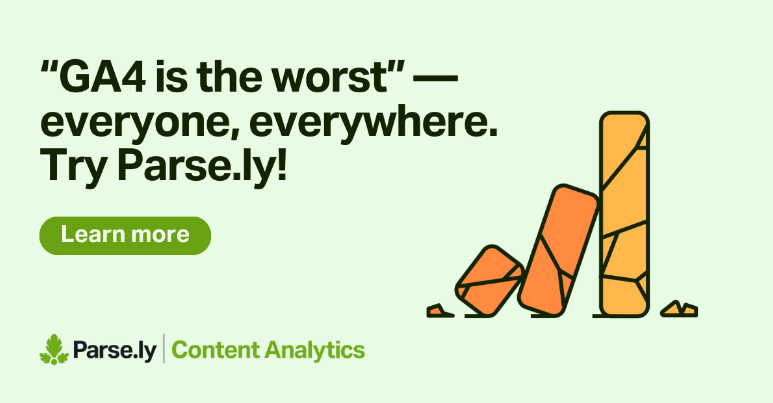Bloomberg Media's approach to product
“Knowing your users is going to become more critical."

Tomorrow from 1:30-2:30pmEST, The Rebooting and Omeda are holding an online forum to discuss new audience strategies in a time of flux, to put it mildly, in traffic patterns. The Guardian’s svp of audience Emilie Harkin and vp of audience Tom Johnson will detail how the news publisher is adapting. If you cannot attend the session live, you’ll get access to the replay. Sign up.
Today, highlights from a conversation I had at the Media Product Forum with Bloomberg head of product Marissa Zanetti-Crume. First a message from WordPress VIP.

Struggling with Google Analytics 4?

GA4 requires a complete retagging of your site, adding unnecessary complexity and cost. Why not switch to a simpler solution? Parse.ly offers easy integration and is built specifically for content teams. Say goodbye to the GA4 headaches and hello to intuitive analytics. Learn more about Parse.ly.
Bloomberg Media’s audience-focused approach to product
Product is a critical function at publishers, serving as the connector between departments but also to the audience. This is due to become more critical as the weight of publishing models shifts to be far more audience-centric.
At Bloomberg, Marissa Zanetti-Crume is the global head of product, leading an organization she sees as both horizontal and vertical, as it supports various organizations from editorial to sales to events while also having vertical responsibilities for core areas like the content-management system. But she also sees product as representing the needs of the audience.
This gets at why product is a critical group, since one of the main challenges for publishers has been making the right tradeoffs as they seek to build sustainable and resilient business models while still serving the audience with what it wants. After all, it’s hard to say the experience on a clean, fast-loading Perplexity page isn’t preferable to the obvious compromises to user experience made at most publishers.
“Knowing your users is going to become more critical. We're working in a time where subscriptions flood the market, and there's so much choice. We're thinking about, in a world of choice, how do we stand out? What is the value? How do we differentiate? Product is the vehicle within an organization who can work with the newsroom and the organization at large and really bring alignment around that audience and who we're serving.”
According to The State of Product at Publishers research The Rebooting recently undertook in collaboration with WordPress VIP, misalignment was the No. 1 challenge identified by product leaders.
Too often different groups, with different KPIs, are at cross purposes. That leads to situations where, in the words of Dotdash Meredith chief product officer Adam McClean, organizations “ship the org chart.” That manifests itself as the Battle of the Overlays on many webpages.
Bloomberg sought to avoid that with a recent refresh of its homepage, which hadn’t been updated in several years. The homepage is having a revival of sorts. That’s because, while it still represents a minority of traffic, it is used by publishers’ most loyal audiences. At a time when depth meets breadth, publishers need to focus on their most ardent audience segments.
That meant making subtle changes like providing data directly on the homepage in response to research finding homepage visitors were loyalists who wanted the Bloomberg POV directly. It grouped articles together to provide deeper information on specific topics, and to satisfy the need for efficiency from its business audience, Bloomberg focused its right rail on a feed of the latest news as well as actively traded stocks.
“One of the things that we've really made a concerted effort around is to keep the user at the forefront of what it is that we are building. We saw that our users were there, our subscribers were there. It was really a place where we could express our brand voice and the value of our work. And so we did a lot of work talking to our users.”
Homepage redesigns are nothing new, of course. But the focus there is part of an overall shift to prioritize the basics in publisher product organizations. With constrained resources, product leaders report focusing on core business objectives. For instance, Bloomberg’s product group build Audience Accelerator, which And even with the swirl of AI, that means the site remains the focal point of efforts.
A core metric Bloomberg tracks is depth of use of various products, whether podcasts, video or articles, in particular repeat engagement that serves as a proxy for habit.
“One of the things that was really important for us is this broader hypothesis that if we can engage our audience, if they find value in our product, they will stick with us over time. That's going to drive revenue in the long term, and that's going to build a really strong audience cohort that marketers are going to want to be around.”
Check out the full conversation with Marissa on this week’s episode of The Rebooting Show on Apple, Spotify, or other podcast platforms.
We surveyed 52 product leaders at publishers to understand their challenges and focuses. We found a renewed emphasis on doing the basics well to serve audiences and deliver on business objectives. Some highlights:
- None of our respondents rated their current product implementation as excellent, and just 12% percent rated it as very good.
- Only 29% of respondents felt prepared for the changes AI will bring.
- Over two-thirds of respondents identified “efficiency” as the biggest likely benefit of AI.
Thanks for reading. Send me a note with feedback by hitting reply.


